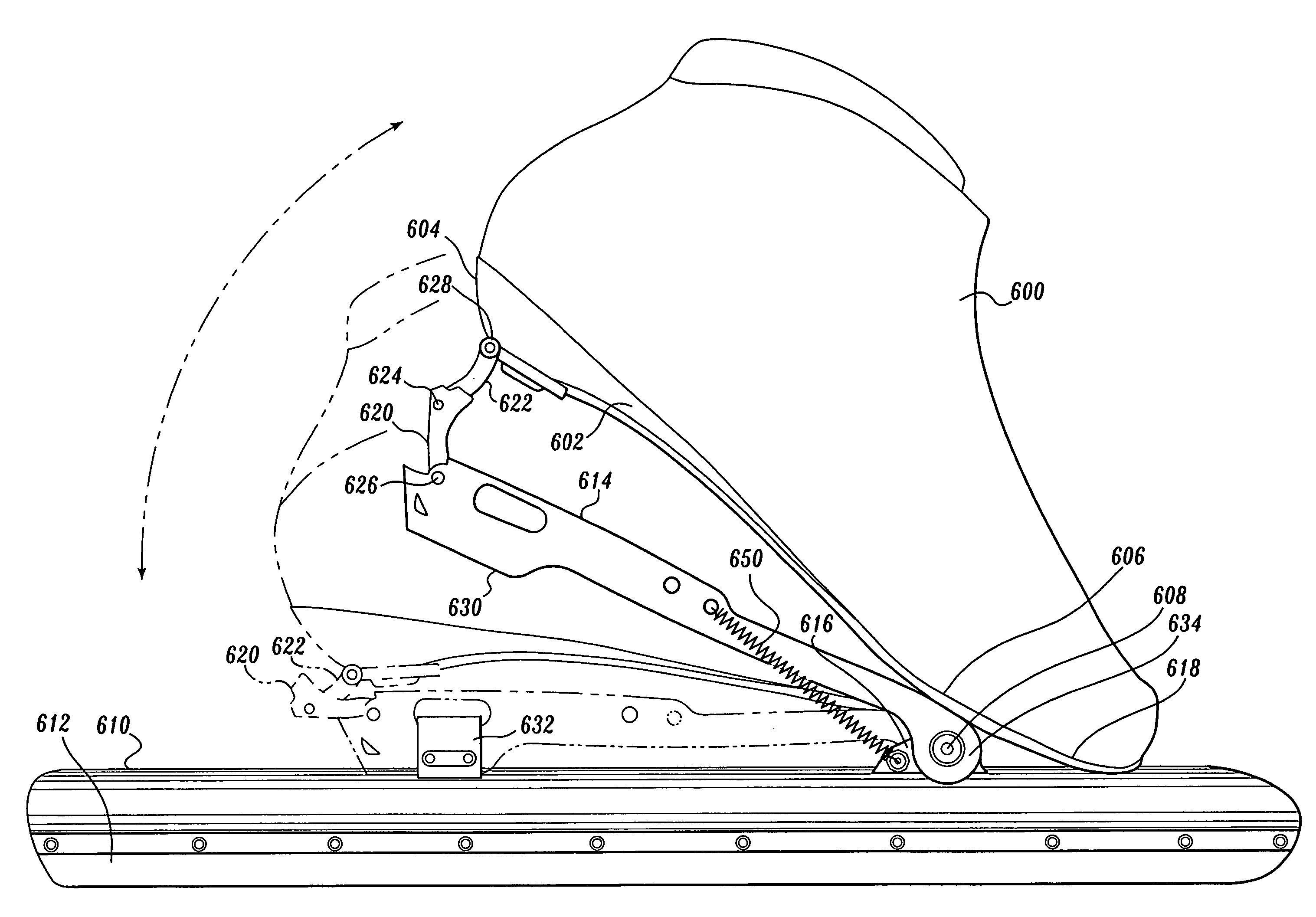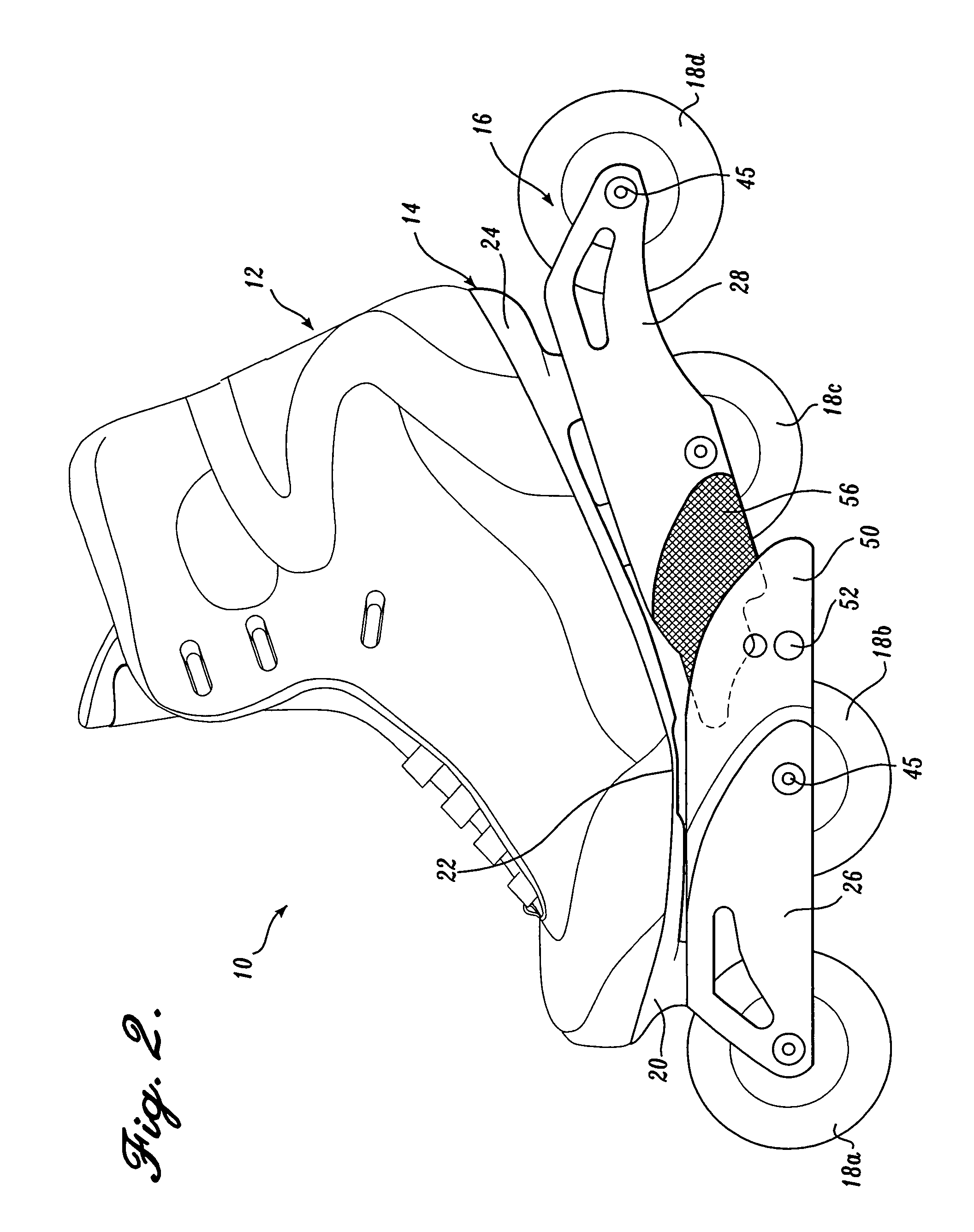Double klap flex base boot with heel linkage
a flexible, boot technology, applied in the direction of skates, snowboard bindings, skating parts, etc., can solve the problems of reducing the efficiency of thrust transfer, reducing the comfort of skaters, increasing friction, and reducing skaters' speed, so as to achieve more power and speed, reduce friction, and be lighter in weigh
- Summary
- Abstract
- Description
- Claims
- Application Information
AI Technical Summary
Benefits of technology
Problems solved by technology
Method used
Image
Examples
third embodiment
[0083]a flexing base skate 210 constructed in accordance with the present invention is illustrated in FIGS. 10 through 13. The skate 210 includes an upper shoe portion 212 that is mounted on and secured to a base 214 that is flexible below the metatarsal head of the skater's foot. The base 214 is secured to a split frame assembly 216 that extends longitudinally beneath the base 214 and rotatably connects to a plurality of wheels 218A, 218B, 218C, 218D between first and second opposing longitudinal sidewalls. The base 214 includes a forefoot region 220 having a metatarsal head portion 222 that underlies the metatarsal head of a skater's foot, and a heel region 224 underlying the skater's heel. The frame assembly 216 includes a forward frame segment 226 secured to the forefoot region 220 of the base 214, and a rearward frame segment 228 that is secured to the heel region 224 of the base 214.
[0084]The forward frame segment 226, rearward frame segment 228, and flexible base 214 cooperat...
first embodiment
[0085]Referring to FIGS. 10 and 11, the upper shoe portion 212 surrounds the toes, sides, heels, and ankle of a skater's foot and is constructed at least partially from flexible materials so that the upper shoe portion 212 will flex together with the base 214. The base 214 is best viewed in FIGS. 10 and 12. The base 214 is secured to the upper shoe portion 212 by any conventional method and may optionally include rigidizing ribs (not shown) similar to the ribs 41 described above. The flexibility of the metatarsal head portion 222 of the base 214 is enhanced by the formation of a transverse, elongate aperture 242 (shown in FIG. 12) that extends transversally and centrally across approximately half of the width of the metatarsal head portion 222, in exactly the same manner as the elongate aperture 42 described with respect to the first embodiment shown in FIG. 1. Thus, the base 214 and upper shoe portion 212 flex at the anatomically preferred position just below the metatarsal head or...
fourth embodiment
[0095]A greater number of wheels, such as five wheels, may be desired for greater speed. a flexing base skate 310, constructed in accordance with the present invention, is shown in FIGS. 14-17. The skate 310 includes an upper shoe portion 312 that is attached to a flexible base 314, having a forefoot region 320 that includes a metatarsal head portion 322, and a heel region 324. The base 314 is attached to a split frame assembly 316 that supports five wheels 318 that are rotatably mounted on axles 345. The forward frame segment 326 includes a horizontal top wall 331, two parallel side walls 332 depending vertically from the top wall 331, and a horizontal brace 327 to form a sturdy box frame structure. The rearward frame segment 328 similarly includes a horizontal top wall 334, two parallel sidewalls 336, and a horizontal brace 327, also forming a sturdy box frame structure. Three forward wheels 318 are rotatably journaled on axles 345 between the sidewalls 332 of the forward frame se...
PUM
 Login to View More
Login to View More Abstract
Description
Claims
Application Information
 Login to View More
Login to View More - R&D
- Intellectual Property
- Life Sciences
- Materials
- Tech Scout
- Unparalleled Data Quality
- Higher Quality Content
- 60% Fewer Hallucinations
Browse by: Latest US Patents, China's latest patents, Technical Efficacy Thesaurus, Application Domain, Technology Topic, Popular Technical Reports.
© 2025 PatSnap. All rights reserved.Legal|Privacy policy|Modern Slavery Act Transparency Statement|Sitemap|About US| Contact US: help@patsnap.com



